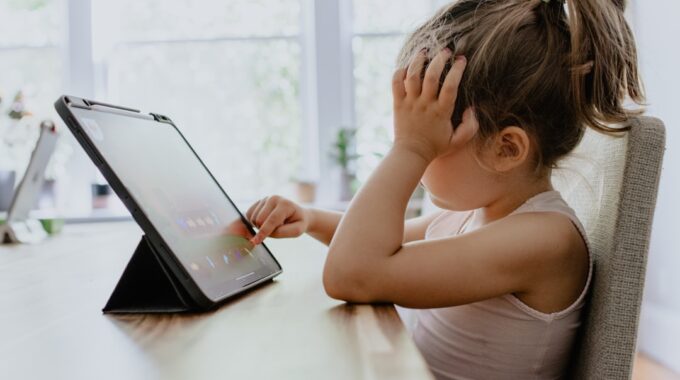What’s the Holistic Approach to My Child’s Eye Problems? Holism, a Greek word meaning ‘whole’…

Screens have become a global issue concerning all of us as parents and caregivers who care about children’s health, particularly their eye health.
Here are some important points to consider about this subject:
Effects of Screen Use on Children’s Eyes:
Myopia (Nearsightedness)
Increasing evidence suggests that excessive screen time, especially when coupled with insufficient outdoor activity, is linked to the development of myopia in children.
The close-up focus required for screen use can strain the eyes and affect their growth.
Digital Eye Strain
Digital eye strain is a name for the kinds of symptoms that people experience when they spend too long looking at a screen.
Symptoms of eye strain can include blurry vision, headaches, neck and shoulder pains.

Dry Eyes
Staring at screens often reduces blink rates, leading to dry, irritated eyes.
This can be particularly uncomfortable and can contribute to long-term eye health issues if not addressed.
Blue light exposure
Screens emit blue light, which can disrupt sleep patterns by affecting the production of melatonin.
Prolonged exposure to blue light before bedtime can make it harder for children to fall asleep and affect the quality of their sleep.
Focus and Attention Issue
Excessive screen time can impact children’s ability to focus on other tasks and may contribute to difficulties in maintaining attention during non-screen activities.
Recommendations for Amount of Screen Time for Children
The recommendations for the amount of screen time for children vary by age and are based on guidelines from health organizations like the American Academy of Pediatrics (AAP). Here are the general recommendations:
- Infants and Toddlers (0-24 months)
Avoid Screen Time: No screen time is recommended, except for video chatting with family and friends, which can help with social interaction.
- Preschoolers (2-5 years)
1 Hour Per Day: Screen time should be limited to one hour per day of high-quality programming. Co-viewing with parents or caregivers is encouraged to help children understand and apply what they are seeing.
- School-aged Children (6 years and older)
Consistent Limits: Ensure consistent limits on the time spent using media and the types of media. Make sure screen time does not interfere with getting enough sleep, physical activity, and other behaviors essential to health.
How to Protect Children’s Eyes During Screen Time
Protecting children’s eyes from screens is crucial given the increasing amount of time they spend on digital devices.
Here are several strategies to help safeguard their eye health:
1. Limit Screen Time
Set reasonable limits on screen time, especially for young children.
2. Follow the 20-20-20 Rule
Encourage children to take a break every 20 minutes by looking at something 20 feet away for at least 20 seconds. This helps reduce eye strain.
3. Adjust Screen Settings
Adjust the brightness of the screen to match the lighting in the room.
Ensure the text size is large enough to read comfortably.
4. Maintain Proper Distance and Posture
- Distance: Keep the screen at least an arm’s length away (about 18-24 inches).
- Angle: The screen should be slightly below eye level to reduce neck strain.
- Posture: Encourage children to sit up straight, with feet flat on the floor.
5. Use Blue Light Filters
Consider using blue light filters or glasses that block blue light from screens.
Many devices come with a “night mode” or “blue light filter” setting.
6. Encourage Outdoor Activities
Outdoor play helps relax the eyes and reduces the risk of developing nearsightedness (myopia).
Aim for at least 1-2 hours of outdoor activity each day.

7. Ensure Proper Lighting
Avoid using screens in dark rooms.
Ensure there is adequate ambient lighting to reduce the contrast between the screen and the surrounding environment.
8. Regular Eye Exams
Schedule regular eye check-ups to monitor and address any vision issues early.
9. Educate on Eye Health
Teach children about the importance of blinking regularly to keep their eyes moist and how to recognize signs of eye strain, such as headaches or blurred vision.
10. Create a Comfortable Workstation
Set up a child-friendly workstation with an ergonomic chair and desk, ensuring that the computer or tablet is positioned correctly.
Implementing these practices can help minimize the potential negative impacts of screen time on children’s eyes and overall health.
General Tips…
Screen-Free Zones:
Designate certain areas of the home as screen-free zones, such as the dining room and bedrooms, to promote family interaction and better sleep hygiene.
Screen-Free Times:
Establish screen-free times, especially during meals and before bedtime, to ensure that screens do not interfere with sleep or family interactions.
Quality Content:
Prioritize educational and high-quality content.
Role Modeling:
Be a good role model by limiting your own screen time and engaging in other activities.


This Post Has 0 Comments